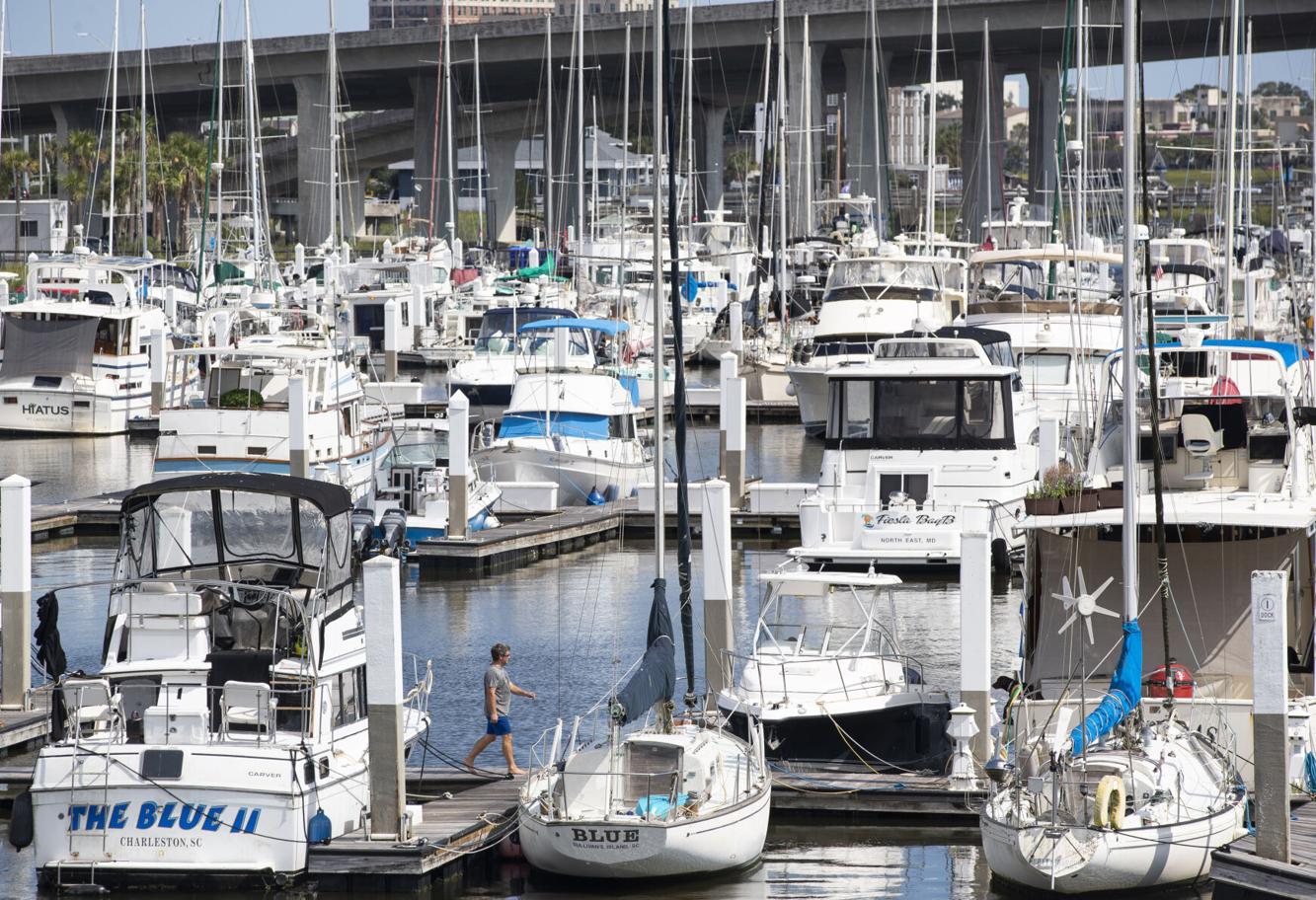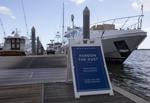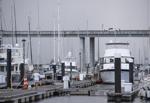What’s a Skipper to Do? Marinas are full in Charleston
Slip rentals in the Lowcountry are expensive, ranging between about $500 and $1,000 a month for people with boats up to 45 feet long. Transient slips are even more.

A man walks down the dock at the Harborage at Ashley Marina in Charleston on Sept. 10, 2023. Henry Taylor/Staff By Henry Taylor htaylor@postandcourier.com
Many boat owners in the Charleston area have a love/hate relationship with their marinas. Mostly they love the access to year-round wet slips, fuel docks, pump-outs, dock hands, marina toilets, fish cleaning stations and a degree of security.
They hate it when the bill arrives, though.
Slip rentals in the Lowcountry are expensive, ranging between about $500 and $1,000 a month for people with boats up to 45 feet long. (The biggest motor and sailing yachts can pay much more than that, and transient boats pay a premium rate per foot for access to outside docks.)
Perhaps you’ve noticed that the marinas in the area are full, or nearly so. A few of them are expanding. The opportunities are ripe, and some with deep pockets are investing in Charleston’s marine sector, joining a broader consolidation trend.

A sign in reference to dock expansions underway at the Safe Harbor Charleston City Marina on Sept. 10, 2023. Henry Taylor/Staff
The supply clearly is not keeping up with the demand. Part of the reason is population growth. As the region welcomes more residents, some with plenty of disposable income, the number of boats increases, too. Another part of the reason is that waters in the Charleston area are particularly inviting to boaters.
“Boating here is still fantastic on Charleston Harbor,” noted Chuck Laughlin, president of St. Bart’s Yachts, a Beneteau dealer based at the City Marina on the Ashley River. “On any given day you can be one of a few boats out there. It’s still not crowded like Lake Norman outside of Charlotte, where you feel you’re taking your life in your hands.”
And if they are sailboat operators, they can race. The Charleston Ocean Racing Association has registered 30 boats for its annual October “Alice Cup” race between the harbor and Rockville. That’s a big number, much more than in recent years, and it suggests a surging interest in offshore sailing, said Ray Spellerberg, co-owner of the sailboat Celedon. It wasn’t long ago that CORA struggled to generate interest in its offshore races, Spellerberg said.
“It just breaks my heart,” said Rand Pratt, director of operations for Charleston Harbor Marina.
The least expensive is the Cooper River Marina, operated by the Charleston County Parks. The owner of a 30-foot boat who keeps the vessel there long-term will pay a little more than $500 a month.
The others, all privately operated, cost more
A dog walker on the docks of the Safe Harbor Charleston City Marina on Sept. 10, 2023. Henry Taylor/Staff
Spellerberg keeps his boat at Hobcaw Creek Community Docks which, with just 18 slips, is perhaps the smallest marina in the area. If you define “marina” as a place that includes not just slips but services, too, then maybe Hobcaw would not qualify. All it provides is a power pedestal so boats can charge their batteries while at rest.
“We like where we’re at,” Spellerberg said. He and his co-owner live nearby. “We’re grateful we don’t have to go into a larger marina setting. It can get cost prohibitive.”
He pointed out that marina costs represent only a portion of money boat owners spend each year. Merely keeping a boat in good working order requires significant investment.
And too many new boaters don’t know the rules of navigation, which can make things a bit dicey on the water, Spellerberg added.
Expansions
The marina operators know the power they wield. And they recognize an opportunity when they see one. In recent years, Safe Harbor Marinas has purchased the City Marina, the Bristol Marina nearby and the City Boatyard on the Wando River. The Dallas-based company also owns marinas in Beaufort, Hilton Head, Port Royal (two) and Pawley’s Island. Overall, it owns 130 marinas, boatyards and other facilities, located in 24 states and Puerto Rico.

Safe Harbor was purchased by Sun Communities in 2020 for $2 billion.
That company isn’t the only one participating in the consolidation of the marina business. Mike Shuler, owner and managing partner of Bohicket Marina Investors, now controls six properties: Seabreeze Marina, St. John’s Yacht Harbor, Bohicket Marina, Isle of Palms Marina, Ripley Light Yacht Club and Old Village Yacht Club. (Shuler didn’t respond to messages left on his voicemail.)
The City Marina is located on public land, owned by the city of Charleston, and leased to Safe Harbor. And guess what? It’s expanding.
Famous for its Megadock, where the mega yachts tie down when in town, the City Marina is adding dockage space that extends toward the middle of the Ashley River.
“We have almost completed the north Megadock,” General Manager David Isom said. “After that, we will start to attach these 100-foot-long concrete finger piers, then start rebuilding the north basin of the marina.”
Some old concrete walls, remnants of the original marina design that can disrupt the current flow, soon will be removed, he added. That will make it easier and safer to tie up to the new floating docks, which don’t hinder the current, and perhaps help minimize silting.
The new slips are meant for longer and wider boats, Isom said.

A worker walks along a dock addition at Seabreeze Marina in Charleston on Sept. 11, 2023. Henry Taylor/Staff
When all is said and done, the City Marina will be among the largest in the country. Add up the space on both sides of the new Megadock and you get the equivalent of one mile of linear dockage, he said.
Other marinas are getting bigger, too.
Seabreeze, located on the Charleston peninsula in the shadow of the Ravenel Bridge, just added dozens of powerboat slips. And Shuler now is hoping to build a yacht club on that end of Johns Island, near Bohicket Marina.
Charleston Harbor Marina, too, is planning an expansion that will add dozens of slips on the south side of the site, according to Pratt. It’s already installed new breakwaters that are wider, deeper and offer better protection from westerly weather.
“We’re primarily trying to protect our investment,” he said. Though the added revenue certainly is another reason.
The future could see more linear dockage on the north side of the marina, meant to accommodate a growing number of catamarans, Pratt said. Plus College of Charleston Sailing, which is based in the marina, is looking to grow, he said.

An intense sunset viewed from Charleston Harbor Marina earlier this year. Adam Parker/Staff
Demand is high for space, and the marina maintains a wait list, though the wait period isn’t crazy yet, Pratt said.
A big challenge is updating the marina to keep pace with changes in boating behavior and design. Boats are bigger now. A marina designed 35 years ago might not be sufficiently equipped to accommodate all of today’s boaters.
Not all marinas are built alike. Most rely on long wooden pilings along which the docks float up and down according to the tides. At City Marina, the water must rise 17 feet before the docks slip off the top of the pilings and float away.

A view from Charleston Harbor Marina at sunset on a calm evening. Adam Parker/Staff
Charleston Harbor Marina instead relies on a Swedish design developed to manage the big tidal swings of the North Sea. The docks are held in place not by pilings but by crisscrossed chains anchored to the harbor floor. The marina’s only pilings are support structures for powerboat lifts. Some were recently added to bring the total number of mechanical lifts to 42.
Needless to say, upgrades are expensive. So is regular maintenance, especially in an area with a soft bottom that sometimes needs dredging and the annual threat of tropical storms. Pratt wouldn’t name a figure saying only that his annual operating costs were “astronomical.”
It doesn’t cost that much to maintain a mooring field. There’s a new one in the Wando River, 1 River Landing, near the Daniel Island Yacht Club. For a 30-foot boat, you pay $275 a week, $475 a month or $4,320 a year. (Bigger boats pay more.)
Laughlin said business is good. The demand for his Beneteau sailboats and powerboats remains pretty high. There was an uptick in sales during the pandemic, despite a manufacturing shortage because of COVID’s impacts on factories trying to keep their employees safe.
When he started out 36 years ago, a big Beneteau cost perhaps $150,000, he said. Today it’s approaching $7 million.
It’s worth noting that many boat companies have manufacturing operations here in South Carolina. The state Department of Commerce recognizes 28 boat makers headquartered here, including a few big ones: Scout, Sportsman and Key West. (Beneteau had a factory in Marion, but closed it in 2020. The facility was purchased by a Canadian swimming pool company which, like boat manufacturers, molds fiberglass.)

A small boat drives past others docked in their slips on the Ashley River in Charleston on Sept. 10, 2023. Henry Taylor/Staff
As of the beginning of 2023, the total number of registered recreational boats in South Carolina was about 360,000, according to the Department of Natural Resources. A little more than 317,000 are powerboats; 2,000 are sailboats.
Many powerboats are kept in dry stack marinas, of which there are several in the area. Perhaps the majority of powerboats are trailered and kept in driveways. Owners ease them in and out of the water at designated boat ramps.

Boats can be seen through a decorative gate at the Safe Harbor Charleston City Marina on Sept. 10, 2023. Henry Taylor/Staff
A recent trend affords recreational boaters the chance to get on the water without owning a vessel. Boat clubs are on the rise. Pay a membership fee and get access to a fleet of small powerboats. The City Marina is home to two such clubs. Seabreeze has one, too. Fortunately for them, the powerboat market is strong. The pandemic inspired some people to invest in new boats. Now that the worst of COVID is past and the market is leveling off again, there’s some excess inventory, noted Isom. What will happen to those vessels?
“The boat clubs are going to start buying them up,” he said.
Which means we’ll see even more people on the water, many with little boating experience. And that means an increase in the “danger level,” as Spellerberg has warned.
He hopes they will learn the etiquette and the rules before they throttle up.







Be the first to comment!